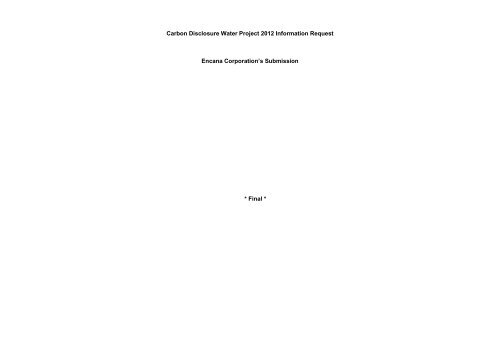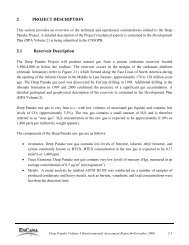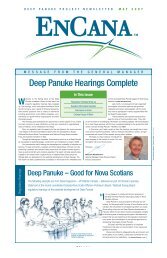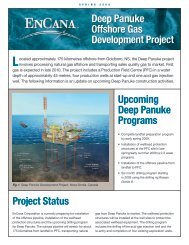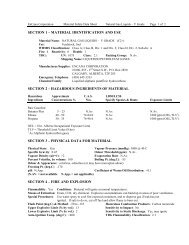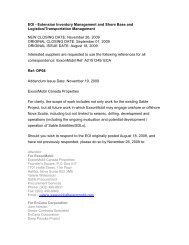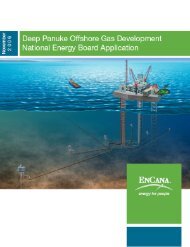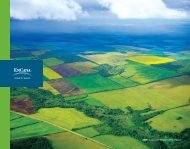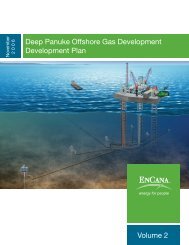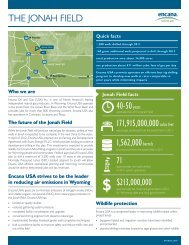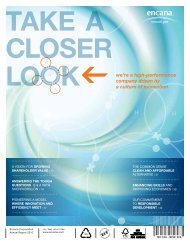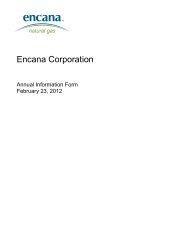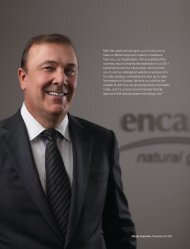Carbon Disclosure Project - Encana
Carbon Disclosure Project - Encana
Carbon Disclosure Project - Encana
You also want an ePaper? Increase the reach of your titles
YUMPU automatically turns print PDFs into web optimized ePapers that Google loves.
<strong>Carbon</strong> <strong>Disclosure</strong> Water <strong>Project</strong> 2012 Information Request<strong>Encana</strong> Corporation’s Submission* Final *
ADVISORY ON FORWARD-LOOKING STATEMENTSFuture Oriented InformationIn the interests of providing <strong>Encana</strong> Corporation (“<strong>Encana</strong>” or the “Company”) shareholders and potential investors with information regarding <strong>Encana</strong>, including management’s assessment of <strong>Encana</strong>’s and itssubsidiaries’ future plans and operations, certain statements contained in this document are forward-looking statements or information within the meaning of applicable securities legislation, collectively referred toherein as “forward-looking statements.” Forward-looking statements in this document include, but are not limited to: achievement of the company’s objectives to maintain financial strength, optimize capitalinvestments, and pay stable dividend by low-cost production growth; estimated reserves and forecast 2012 production of natural gas and liquids; expected increase in natural gas demand from various sectors in thefuture and potential for natural gas in a carbon-constrained environment; projected development of Kitimat LNG project and expectation to access new markets; and estimated years of supply of natural gas in NorthAmerica at current production rates.Readers are cautioned not to place undue reliance on forward-looking statements, as there can be no assurance that the plans, intentions or expectations upon which they are based will occur. By their nature,forward-looking statements involve numerous assumptions, known and unknown risks and uncertainties, both general and specific, that contribute to the possibility that the predictions, forecasts, projections andother forward-looking statements will not occur, which may cause the Company’s actual performance and financial results in future periods to differ materially from any estimates or projections of future performanceor results expressed or implied by such forward-looking statements. These assumptions, risks and uncertainties include, among other things: volatility of, and assumptions regarding natural gas and liquids prices,including substantial or extended decline of the same and their adverse effect on the Company’s operations and financial condition and the value and amount of its reserves; assumptions based upon theCompany’s current guidance; fluctuations in currency and interest rates; risk that the Company may not conclude divestitures of certain assets or other transactions (including third-party capital investments, farmoutsor partnerships, which <strong>Encana</strong> may refer to from time to time as “partnerships” or “joint ventures”, regardless of the legal form) as a result of various conditions not being met; product supply and demand;market competition; risks inherent in the Company’s and its subsidiaries’ marketing operations, including credit risks; imprecision of reserves estimates and estimates of recoverable quantities of natural gas andliquids from resource plays and other sources not currently classified as proved, probable or possible reserves or economic contingent resources, including future net revenue estimates; marketing margins;potential disruption or unexpected technical difficulties in developing new facilities; unexpected cost increases or technical difficulties in constructing or modifying processing facilities; risks associated withtechnology; the Company’s ability to acquire or find additional reserves; hedging activities resulting in realized and unrealized losses; business interruption and casualty losses; risk of the Company not operating allof its properties and assets; counterparty risk; downgrade in credit rating and its adverse effects; liability for indemnification obligations to third parties; variability of dividends to be paid; its ability to generatesufficient cash flow from operations to meet its current and future obligations; its ability to access external sources of debt and equity capital; the timing and the costs of well and pipeline construction; theCompany’s ability to secure adequate product transportation; changes in royalty, tax, environmental, greenhouse gas, carbon, accounting and other laws or regulations or the interpretations of such laws orregulations; political and economic conditions in the countries in which the Company operates; terrorist threats; risks associated with existing and potential future lawsuits and regulatory actions made against theCompany; risk arising from price basis differential; risk arising from inability to enter into attractive hedges to protect the Company’s capital program; and other risks and uncertainties described from time to time inthe reports and filings made with securities regulatory authorities by <strong>Encana</strong>. Although <strong>Encana</strong> believes that the expectations represented by such forward-looking statements are reasonable, there can be noassurance that such expectations will prove to be correct. Readers are cautioned that the foregoing list of important factors is not exhaustive. In addition, assumptions relating to such forward-looking statementsgenerally include <strong>Encana</strong>’s current expectations and projections made in light of, and generally consistent with, its historical experience and its perception of historical trends, including the conversion of resourcesinto reserves and production as well as expectations regarding rates of advancement and innovation, generally consistent with and informed by its past experience, all of which are subject to the risk factorsidentified elsewhere in this document.Furthermore, the forward-looking statements contained in this document are made as of the date hereof and, except as required by law, <strong>Encana</strong> undertakes no obligation to update publicly or revise anyforward-looking statements, whether as a result of new information, future events or otherwise. The forward-looking statements contained in this document are expressly qualified by this cautionary statement.Advisory Regarding Reserves Data & Other Oil & Gas Information<strong>Disclosure</strong> ProtocolsNational Instrument (“NI”) 51-101 of the Canadian Securities Administrators imposes oil and gas disclosure standards for Canadian public companies such as <strong>Encana</strong> engaged in oil and gas activities. <strong>Encana</strong>complies with the NI 51-101 annual disclosure requirements in its annual information form, most recently dated February 23, 2012 (“AIF”). The Canadian protocol disclosure is contained in Appendix A and under“Narrative Description of the Business” in the AIF. <strong>Encana</strong> has obtained an exemption dated January 4, 2011 from certain requirements of NI 51-101 to permit it to provide certain disclosure prepared in accordancewith U.S. disclosure requirements, in addition to the Canadian protocol disclosure. That disclosure is primarily set forth in Appendix D of the AIF.
<strong>Carbon</strong> <strong>Disclosure</strong> <strong>Project</strong>CDP Water <strong>Disclosure</strong> 2012 Information Request<strong>Encana</strong> CorporationModule: Introduction - 2012 CDP Water <strong>Disclosure</strong>Page: Introduction - 2012 CDP Water <strong>Disclosure</strong>0.1IntroductionPlease give a general description and introduction to your organization.<strong>Encana</strong> Corporation (“<strong>Encana</strong>” or the “Company” or the “Corporation”) is a leading North American energy producer focused on pursuing the highest returns fromits significant portfolio of natural gas, oil and natural gas liquids. Recognized for its expertise in resource play development, <strong>Encana</strong> is a disciplined, innovativecompany committed to responsible development. <strong>Encana</strong> is pursuing the key business objectives of maintaining financial strength, optimizing capital investmentsin the Company’s highest return projects and continuing to pay a stable dividend to shareholders as it pursues disciplined, responsible and reliable low-costproduction growth.<strong>Encana</strong>’s extensive portfolio of reserves and economic contingent resources in high-growth resource plays in major North American basins serves as thefoundation for the Company’s long-term strategy of accelerating the value recognition of its assets. <strong>Encana</strong> has a history of entering prospective basins early andleveraging technology to unlock resources and build the underlying productive capacity at a low cost.<strong>Encana</strong> continually strives to improve operating efficiencies, foster technological innovation and lower cost structures, while mitigating its environmental footprintthrough resource play optimization. The Company’s resource play hub model, which utilizes highly integrated production facilities, is used to develop resourcesby drilling multiple horizontal wells from centralized pad sites. Repeatable operations lend themselves to ongoing cost reductions through optimization ofequipment and processes by applying continuous improvement techniques.<strong>Encana</strong> is organized into Divisions which represent the Company’s operating and reportable segments as follows: Canadian Division includes the exploration for, development of, and production of natural gas, oil, NGLs and other related activities within Canada. Fivekey resource plays are located in the Division: (i) Cutbank Ridge in northern British Columbia; (ii) Peace River Arch in northwest Alberta; (iii) GreaterSierra in northeast British Columbia, including Horn River; (iv) Bighorn in west central Alberta; and (v) Coalbed Methane (“CBM”) in southern Alberta.The Canadian Division also includes the Deep Panuke natural gas project offshore Nova Scotia. USA Division includes the exploration for, development of, and production of natural gas, oil, NGLs and other related activities within the U.S. Four keyresource plays are located in the Division: (i) Jonah in southwest Wyoming; (ii) Piceance in northwest Colorado; (iii) Haynesville in Louisiana; and(iv)Texas.
Market Optimization is primarily responsible for the sale of the Company’s proprietary production. These results are included in the Canadian and USADivisions. Market optimization activities include third-party purchases and sales of product that provide operational flexibility for transportationcommitments, product type, delivery points and customer diversification. These activities are reflected in the Market Optimization segment.Corporate and Other mainly includes unrealized gains or losses recorded on derivative financial instruments. Once amounts are settled, the realizedgains and losses are recorded in the operating segment to which the derivative instrument relates.Market Optimization sells substantially all of the Company’s upstream production to third-party customers. Transactions between segments are based on marketvalues and eliminated on consolidation. Financial information is presented on an after-eliminations basis.With approximately 12 million net acres of land, 14.2 trillion cubic feet equivalent of proved reserves as of December 31, 2011 and forecasted 2012 production ofapproximately 3,000 million cubic feet per day (MMcf/d) of natural gas and 30 thousand barrels a day (Mbbls/d) of liquids, <strong>Encana</strong> will continue to be a leader inNorth American gas production. <strong>Encana</strong> common shares trade on the Toronto and New York stock exchanges under the symbol ECA.Paramount to <strong>Encana</strong>'s strategy is its commitment to safety, the environment and the community and to operating its business ethically and responsibly. <strong>Encana</strong>was named to the Oil and Gas Producers’ sector of the 2011 Dow Jones Sustainability North American Index and made the list of the world’s most ethical largecompanies by the Ethisphere Institute.0.2Reporting YearPlease state the start and end date of the year for which you are reporting data.Enter the period that will be disclosed.Fri 01 Jan 2011 - Fri 31 Dec 20110.3Reporting BoundaryPlease indicate the category that describes the company, entities, or group for which you are reporting.Companies over which financial control is exercised per consolidated audited financial statements for the year ended December 31, 2011.
0.4ExclusionsAre there any geographies, activities, facilities or types of water inputs/outputs within this boundary which are not included in your disclosure?NoModule: 2012-Water-ManagementPage: 2012-Water-1-ManagementGovernance1.1Does your company have a water policy, strategy or management plan?Yes1.1aPlease describe your policy, strategy or plan, including the highest level of responsibility for it within your company and its geographical reachGeographical reachGlobalDescription of policy, strategy or planPolicy: <strong>Encana</strong> Corporation has an Environment Policy with specific reference to the responsiblesourcing, handling and disposal of water. <strong>Encana</strong> manages water use by way of area-specific operatingpractices, which provide guidance on the use of potable and non-potable water, water storage, handlingand disposal. These practices take into account location-specific conditions and regulations. In addition,<strong>Encana</strong> has an environmental stewardship standard and an associated guidance document on waterquality and quantity through <strong>Encana</strong>’s Environment, Health & Safety (EH&S) management system, Ethos.This system provides guidance on the development and implementation of practices and procedures.Position of responsiblepersonBoard/Executive Board
GlobalGlobalGlobalGlobalStrategy: The use of water plays a crucial role in developing natural gas resources. Protecting thisnatural resource and using it wisely is important to <strong>Encana</strong>’s continued success. <strong>Encana</strong> adapts its watermanagement approach to address geological factors, local water resources, stakeholder feedback andoperational needs. This means no single water management approach works in all of <strong>Encana</strong>’s operatingareas and the water sources we use vary from region to region. <strong>Encana</strong> recognizes that its waterrequirements and the challenges posed by its operations require tailored approaches to watermanagement. However, <strong>Encana</strong> also has general principles that apply across its operations.Strategy: Where practical, <strong>Encana</strong> seeks opportunities to use unutilized sources of water. This could bewater that’s located far deeper than typical water wells and drinking water aquifers. It also could be waterthat is of too poor quality for household or other industrial use. <strong>Encana</strong> reuses water in its operationswhere possible. Where produced water cannot be reused, it is disposed of responsibly, in accordancewith applicable regulation, to avoid the potential contamination of freshwater resources or land.<strong>Encana</strong> manages the water requirements for it’s resource plays on a case-by-case basis. These regionspecificassessments consider issues such as water requirements, potential sources and regulations.This involves consultation with a variety of both internal and external stakeholders.The water sourcingand usage is then optimized as needed.Strategy: Water resource issues are highly localized and vary from location to location. Managing waterand water resource impacts is the responsibility of the business unit vice-presidents, subject matterexperts and local site management. Each operating unit manages its environmental performance usingEthos, <strong>Encana</strong>’s EH&S management system. Significant environmental aspects and impacts areassessed and those relating to water resources are evaluated. Where necessary, appropriatemanagement plans are established to address significant water-related environmental impacts (e.g.,unplanned releases to surface water and/or groundwater).Policy: Each <strong>Encana</strong> employee has a responsibility for understanding and being accountable for<strong>Encana</strong>’s Environmental Policy. This includes identifying and assessing environmental risks and impactsarising from <strong>Encana</strong>’s activities and adopting technically sound measures to avoid or mitigate risks.<strong>Encana</strong>’s policy outlines its commitment to sourcing, handling and disposing of water responsibly.Training is available to all employees regarding <strong>Encana</strong>’s Environmental policy.Plan: Increase awareness regarding <strong>Encana</strong>’s management of water related risks, practices andopportunities. The key aspect of this goal is to develop open, proactive and responsive communicationwith internal and external stakeholders.Manager not reporting directlyto the BoardOfficer/manager not directlyreporting to the boardOther: EmployeesOfficer/manager not directlyreporting to the board1.1bDoes the policy, strategy or plan specify water reduction, quality or efficiency targets or other water-related goals?
Yes1.1cPlease describe these water-related targets or goalsGeographicalreachType ofTarget/goalTarget/GoalProgress Against Target or GoalGlobalGlobalDirectOperationsDirectOperationsDevelop guidance for operational teamsthat outlines <strong>Encana</strong>’s expectations withregards to tracking and promoting theefficient use of water as well as protect thequality of surface water and groundwater.<strong>Encana</strong> seeks opportunities to useunutilized sources of water. This could bewater that’s located far deeper than typicalwater wells and drinking water aquifers. Italso could be water that is of too poorquality for household or other industrialuse.• In 2011 <strong>Encana</strong> completed water quality and quantity guidance forproper development and implementation of Water Quality andQuantity practices and procedures across its operations.• In 2011 <strong>Encana</strong> hired a third party to identify and map current wateruse across its operations, including where water data is coming from,the reporting hierarchy associated with the data (how the data iscompiled and to whom the data is reported to) and any control gaps.This is an important step in creating a system that accurately collectsand reports water information.• In 2011, faced with challenging drought conditions near its operationsin north Louisiana, <strong>Encana</strong> actively began seeking opportunities toreduce its dependence on sourcing fresh water and increase thepercentage of recycled water used for hydraulic fracturing. As such,<strong>Encana</strong> approached local contractors to find alternative sources ofwater. Through the collaborative efforts of <strong>Encana</strong>’s completions andenvironmental teams and their partners, <strong>Encana</strong> was able to sourceeffluent wastewater from a local pulp mill in order to displace some ofthe surface water used in its operations. The pulp mill water, whichproved to be a readily available source of water for hydraulicfracturing operations, requires less surface pipeline infrastructure,less dependence on water transfer ponds and provides significantcost savings.GlobalDirectOperations<strong>Encana</strong> reuses water in its operationswhere possible. Where produced watercannot be reused, it is disposed ofresponsibly, in accordance with applicableregulation, to avoid the potentialcontamination of freshwater resources orland.• In 2011 <strong>Encana</strong> completed water quality and quantity guidance forproper development and implementation of Water Quality andQuantity practices and procedures across its operations.
GlobalTransparency<strong>Encana</strong> will communicate its commitmentto environmental stewardship to itsstakeholders and integrate environmentalstewardship into its business planning anddecision-making processes.• In 2011, <strong>Encana</strong> refreshed its website and added significantinformation with regards to its practices on water use and hydraulicfracturing (http://www.encana.com/environment/water/).• <strong>Encana</strong> is an active participant in both the Canadian and U.S.versions of FracFocus and continues to support the increaseddisclosure of information regarding the composition of fluids used inhydraulic fracturing. FracFocus is an online hydraulic fracturingchemical registry designed for companies, including <strong>Encana</strong>, toprovide the public with information related to the chemicals used forhydraulic fracturing.• In 2011 <strong>Encana</strong> participated in CDP Water disclosure and DJSI andmade its response available on its website.(http://www.encana.com/investors/esg.html)• <strong>Encana</strong> publishes an annual Corporate Responsibility report whichhighlights its environmental performance and initiatives (attached).
GlobalDirectOperations<strong>Encana</strong> is committed to identifying andassessing environmental risks andimpacts arising from its activities andadopts measures to avoid or mitigate risksand negative environmental impacts.• <strong>Encana</strong> developed and implemented a company-wide program tomanage the chemical products used in hydraulic fracturingoperations. The Responsible Products Program, which begandevelopment in the first quarter of 2010, allows <strong>Encana</strong> to assess itshydraulic fracturing fluids for effectiveness and potential health, safetyand environmental impacts. In July 2011, <strong>Encana</strong> shared this riskbasedprogram with the Canadian Association of PetroleumProducers (CAPP) as a potential tool for industry to proactivelyaddress stakeholder concerns related to the chemicals used inhydraulic fracturing. CAPP and its members are now working with<strong>Encana</strong> to facilitate an industry-wide rollout of the program in Canada.All of the hydraulic fracturing fluid products <strong>Encana</strong> uses areassessed for their potential impact to human health or theenvironment using widely accepted toxicological criteria. The programuses government databases and information from EnvironmentCanada, the European Union, the U.S. Environmental ProtectionAgency and the American Conference of Governmental IndustrialHygienists as the basis for its classification.• In 2011 <strong>Encana</strong> completed closing approximately 180 historic andactive pits containing drill cuttings and completion flowback water inits Piceance Basin. The basin has now moved to a closed-loop watermanagement system and <strong>Encana</strong> is committed to avoidingconstruction of any new drilling or flowback pits on pad sites. In doingso, the South Piceance team has been able to address a number ofcommunity concerns regarding perceived risks to groundwater andwildlife.
GlobalCommunityEngagement<strong>Encana</strong> is committed to align itscommunity investments with theCompany’s business strategy to providemutually-beneficial relations ships withcommunity and non-governmentalorganizations.• In September 2011 <strong>Encana</strong> partnered with Ontario-based Waterlution tobring together environmental groups, industry and academia for a threedayresidential workshop discussing water use in natural gasdevelopment. Canadian leaders in resource management and relatedfields from across Canada were flown to <strong>Encana</strong>'s operations near FortNelson to engage in dialogue about water management and natural gasdevelopment.• <strong>Encana</strong> worked with National Energy Education Development (NEED)<strong>Project</strong> to bring balanced energy programs to USA schools with a focuson strong teacher professional development, timely and balancedcurriculum materials, signature program capabilities and turn-keyprogram management.CanadaPublic Policy<strong>Encana</strong> is actively engaged in publicpolicy discussion. The Company monitors,assesses and plans for potential risks andopportunities presented by environmentalpolicy. <strong>Encana</strong> continuously evaluates andupdates the Company’s strategy in orderto prepare for new and potential risks asthey arise. <strong>Encana</strong> continues to work withgovernments, academics and industryleaders to develop and respond toemerging issues associated with watersourcing, use and disposal.• <strong>Encana</strong> continues to be active in industry associations and committeesthat address water sourcing, use and disposal. <strong>Encana</strong>’s Vice-President of Corporate EH&S, Security and Corporate Responsibilitywas chair of the Canadian Association of Petroleum Producers (CAPP)Shale Water Steering Committee. In 2011 CAPP developed guidingprinciples for Hydraulic Fracturing that emphasize public disclosure andthe protection of water resources.1.2Do you wish to report any actions outside your water policy, strategy or management plan that your company has taken to manage water resources orengage stakeholders in water-related issues?GeographicalreachCategory of ActionDescription of Action and outcome
GlobalCommunityEngagementBeyond its own operations, <strong>Encana</strong> actively engages stakeholders in addressing water-related issues.<strong>Encana</strong> has worked with non-governmental organizations on various projects to benefit water and aquatichabitats. <strong>Encana</strong>’s water stewardship program is built on principles of strong leadership, stakeholder engagementinnovation and performance. Some of the programs <strong>Encana</strong> was involved in 2011 are listed below:• Acted as lead sponsor for the Alberta EcoTrust Foundation River Rally 2011 Conference, which gatheredapproximately 100 individuals across Alberta who are working to protect local watersheds.• Sponsored Wetlands Restoration, teaching Water Garden, and wetlands education.• Sponsored Centre for Affordable Water & Sanitation Technology (CAWST) youth wavemakers program thatbrings students together to build knowledge and awareness of local and global water issues and assist them increating and operating water stewardship action projects in their communities.• Developed a partnership with RiverWatch institute to provide funds to disadvantaged high school students toparticipate in hands-on environmental water education programs.• Worked with SEEDS Canada Foundation to develop a water-focused education and action programs for highschool students.• Partnered with public conservation agencies to develop a project that promotes water quality managementpractices in Wyoming.• Worked with Service Learning Texas to support the Texas Healthy Habitats initiative. Each year, the HealthyHabitats program awards 15 service-learning grants to Texas schools and groups that focus on restoringnatural environments in and around Texas.Module: 2012-Water-RisksOpsPage: 2012-Water-2-indicators-op2.1Are any of your operations located in water-stressed regions?No2.1a
Please specify the method(s) you use to characterize water-stressed regionsMethod used to define waterstressPlease add any comments here:Other: Mapping/Regulatory Tools<strong>Encana</strong> does not operate in water-stressed areas. <strong>Encana</strong> does operate in water-short areas, although water shortageshave not affected our business. Although southern Alberta is considered a water-short area by the Government ofAlberta, <strong>Encana</strong>’s operations have not been restricted by the regulators. <strong>Encana</strong> has adapted to operating in a watershortarea in Southern Alberta and rarely withdraws directly from natural water bodies in the South Saskatchewan RiverBasin. To date, <strong>Encana</strong>’s operations have not been affected by inability to access water. The Rocky Mountain region ofthe U.S. has an appropriation-based water rights system. During certain years, rivers can go “on call” by senior waterrights users and there can be water restrictions. <strong>Encana</strong>’s operations have not been significantly impacted by thesecalls.2.1bPlease list the water-stressed regions where you have operations and the percentage of your total operations in that areaCountryRegion withincountryProportion ofoperations located inthis region (%)Further commentsNotapplicableSee comments <strong>Encana</strong> does not operate in water-stressed areas.2.2Are there other indicators (besides water stress) which you wish to report that help you to identify which of your operations are located in regionssubject to water-related risk?
Not applicable2.2aPlease list the regions at risk where you have operations, the relevant risk indicator and proportion of your total operations in that area.Country orgeographical reachRegion within countryRisk IndicatorProportion of operations locatedin this region (%)Further comments2.3Please specify the total percentage of your operations that are located in the regions at risk which you identified in questions 2.1 and/or 2.20%2.4Please specify the basis you use to calculate the percentages used for questions 2.1 and/or 2.2<strong>Encana</strong> does not operate in water-stressed areas.Page: 2012-water-indicators-scNo2.5Do any of your key inputs or raw materials (excluding water) come from regions subject to water-related risk?
2.5aPlease state or estimate the percentage of your key water-intensive inputs (excluding water) that come from these regionsInputsProportion of material that comesfrom region at risk (%)Unit used forcalculatingpercentageRegional information or further comments<strong>Encana</strong> does not have water intensive inputs which come from regions subject to water-related risk.2.5bYou may explain here why you are not able to identify which of your key water-intensive inputs come from water-stressed regions and whether youhave plans to explore this issue in the futurePage: 2012-water-3-riskassess-opYes3.1Is your company exposed to water-related risks (current or future) that have the potential to generate a substantive change in your businessoperation, revenue or expenditure?3.1aPlease describe the current and/or future risks to your operations, the ways in which these risks affect or could affect your operations and yourcurrent or proposed strategies for managing themCountry orgeographicalreachRisk typeRisk descriptionTimescale(years)PotentialbusinessimpactRisk management strategies
GlobalUnited StatesOther:ReputationalDamageRegulatory:RegulatoryUncertaintyThere is increasing concernfrom stakeholders regardingthe perceived potential tocontaminate drinking waterwith hydraulic fracturing fluidsand flowback.The U.S. EnvironmentalProtection Agency (EPA) iscurrently conducting a study tobetter understand anypotential impacts of hydraulicfracturing on drinking waterand groundwater. Dependingon the findings of the study,there is a potential to impactour hydraulic fracturingoperations.CurrentPotential toaffect schedule,production,reputation andthe environment1-5 years UnknownThe Company ensures that the processes that it has inplace to protect groundwater and minimize environmentalimpact before, during and after wellbore construction arefollowed. This includes proper wellbore construction;installation of effective well casing systems and conductingbaseline groundwater testing programs near <strong>Encana</strong>’sactivities (where appropriate); using water managementpractices at drilling locations to help ensure operations haveminimal impact on the environment; monitoring the integrityof the wells; and using advanced technology to confirm thateach fracture treatment is executed as designed and doesnot migrate out of the targeted formation.<strong>Encana</strong> has been actively engaging with the EPA, otherregulators and trade associations to ensure that theCompany is fully cooperating and disclosing relevantinformation about its operations and practices. <strong>Encana</strong> isalso participating in FracFocus to disclose chemical use tothe public. In addition, <strong>Encana</strong> has developed aResponsible Product Program (described above question1c) to assess the potential health, safety and environmentalimpacts of the products used in hydraulic fracturingoperations.3.1bPlease explain why you do not consider your company to be exposed to any water-related risk in its operationsNot applicable. http://www.encana.com/about/board-governance/policies/corporate-risk.html3.1cPlease explain why you do not know if your company is exposed to any water-related risks that have the potential to generate a substantive change in yourbusiness operation, revenue or expenditure, and if you have plans to assess this risk in the future.Not Applicable
3.2What methodology and what geographical scale (e.g. country, region, watershed, facility) do you use to analyze water-related risk across youroperations?Risk MethodologyCountry orgeographical scale
<strong>Encana</strong> incorporates risk management principles as a part of all activities including developing strategic plans, preparingoperational plans and capital budgets, completing detailed project approval requests, designing and managing projectplans, operating facilities and plants, as a part of other management systems and generally in all decision makingprocesses. For instance, all project approval requests must incorporate a risk assessment and mitigation plan. In addition,risk analysis is incorporated into performance reporting and peer review of projects.Risk is evaluated, managed and documented consistent with guidelines, tools and framework advocated by <strong>Encana</strong>’sCorporate Risk Management Policy and other <strong>Encana</strong> risk management policies and tools such as <strong>Encana</strong>’s EH&S RiskMatrix. Risk is evaluated in terms of the impact on the following areas: people, environment, assets, financial/businessobjectives and reputation. The risk is assigned a probability of occurrence, with a resulting risk level ranging from low toextreme. <strong>Encana</strong>’s Risk Management Process includes nine areas: 1. Risk Content (scope, objectives, risk criteria andtolerances); 2. Risk Assessment; 3. Risk Identification; 4. Risk Analysis; 5. Risk Evaluation; 6. Risk Treatment Strategy; 7.Risk Reporting; 8. Risk Communication and 9. Risk Monitoring and Review.Determining Materiality: When assessing the materiality of environmental risk factors such as water-related risks, <strong>Encana</strong>takes into account a number of qualitative and quantitative factors including, but not limited to, financial, operational,reputational and regulatory aspects of the identified risk factor. These risks are managed by executing policies andstandards designed to comply with or exceed government regulations and industry standards. In addition, <strong>Encana</strong> maintainsa system that identifies, assesses and controls safety, security and environmental risk and requires regular reporting toSenior Management and the Board of Directors.Other: CombinedMonitoring: <strong>Encana</strong> monitors, reviews and understands developments in current and emerging environmental policy andlegislation and considers the associated costs in its strategic planning. <strong>Encana</strong>’s invests in research and development,technology investment and environmental innovation programs to help mitigate potential water-related risks.Reporting: Risk management is a high priority with the Board and <strong>Encana</strong>'s Executive Team. A quarterly risk report isprepared and presented to the Board and the Executive. A more comprehensive report of risks, grouped by financial,operational and strategic risks, is presented to the Board and Executive Team annually. These reports summarize <strong>Encana</strong>'srisks and the approach being taken to address them. In addition, detailed reports including risk analysis are prepared andpresented to the Executive Team and subcommittees of the Board, including the Corporate Responsibility, Environment,Health & Safety (CREHS) Committee, Audit Committee and Reserves Committee.Page: 2012-water-riskassess-sc3.3Do you require your key suppliers to report on their water use, risks and management?No
3.4Is your supply chain exposed to water-related risks (current or future) that have the potential to generate a substantive change in your businessoperation, revenue or expenditure?No3.4aPlease describe (i) the current and/or future risks to your supply chain, (ii) the ways in which these risks affect or could affect your operations beforetaking action, (iii) the estimated timescale of these risks and, (iv) your current or proposed strategies for managing them.Country or geographicalreachRisk type (to supplier)Potential businessimpact (to respondingcompany)Estimate timescale (years)Risk managementstrategies (byresponding company)Not applicable.3.4bPlease explain why you do not consider your supply chain to be exposed to any water-related risksThe use of water plays a crucial role in <strong>Encana</strong>’s ability to develop its natural gas resources. As mentioned in question 3.1.b, <strong>Encana</strong> has an area-specific approach toassessing risk factors including supply chain exposure to water related risk. All EH&S risks, including supply chain water related risks, must be identified and managed.<strong>Encana</strong> has not experienced any material supply chain water related risks to date.3.4cPlease explain why you do not know if your supply chain is exposed to any water-related risks that have the potential to generate a substantive change in yourbusiness operation, revenue or expenditure, and if you have plans to assess this risk in the future.Not applicable.Page: 2012-Water-4-Impacts4.1
Has your business experienced any detrimental impacts related to water in the past five years?There are no specific instances of incidents from the past five years that have detrimentally impacted <strong>Encana</strong>’s business as it relates to water.4.1aPlease describe these detrimental impacts including (i) their financial impacts and (ii) whether they have resulted in any changes to company practices.Not applicable.4.1bPlease explain why you do not know whether your business has experienced any detrimental impacts related to water in the past five years and if you haveany plans to explore this in the future?Not applicable.YesPage: 2012-Water-5-Opportunities5.1Do water-related issues present opportunities (current or future) that have the potential to generate a substantive change in your business operation,revenue or expenditure?5.1aPlease describe (i) the current and/or future opportunities, (ii) the ways in which these opportunities affect or could affect your operations (iii) theestimated timescale and (iv) your current or proposed strategies for exploiting them.Country orgeographicalreachOpportunity typePotential business impactEstimatedtimescaleStrategy to exploit opportunity
GlobalGlobalCost SavingsOther: Reputational ValueBy looking for efficiency in how wesource our water, we can reduceoperational cost associated withhydraulic fracturing.Water use and sourcing is becoming anincreasingly important issue with<strong>Encana</strong>’s stakeholders. Demonstratingresponsible water managementpractices has the potential improvereputation and community acceptance.CurrentCurrent<strong>Encana</strong> will continue to look for innovativeways to source water for our operations.Water requirements and challenges posedby <strong>Encana</strong>’s operations require tailoredapproaches to water management. Wherepractical, <strong>Encana</strong> will continue to work toreduce the use of freshwater through thesourcing of alternatives. <strong>Encana</strong>’s wateruse strategy is consistent across theCompany’s operations; however, theapproach taken is dependent on uniqueregion-specific characteristics. Twoexamples include: The sourcing of effluent wastewaterfrom a local pulp mill in order todisplace some of the surface waterused in <strong>Encana</strong>’s Louisiana operations; Sourcing of deep saline water anddeveloping a treatment plant (Deboltplant) to treat the water in <strong>Encana</strong>’sTwo Island lake operations innortheastern British Columbia. In 2011,the Debolt plant produced more than12.6 million barrels (two million cubicmetres) of water, leaving only 10percent of the water supply needed forhydraulic fracturing to be drawn fromsurface sources.(http://www.encana.com/newsstories/our-stories/environment-deboltfacility.html) Recycling of produced water in thePiceance Basin.<strong>Encana</strong> will communicate its commitmentto environmental stewardship to itsstakeholders and to integrate responsibleenvironmental stewardship into itsbusiness planning and decision-makingprocesses.
5.1bPlease explain why you do not consider water-related issues to present opportunities to your companyNot applicable.5.1cPlease explain why you do not know whether water-related issues present opportunities to your company that have the potential to generate asubstantive change in your business operation, revenue or expenditure.Not applicable.Page: 2012-Water-6-tradeoffsYes6.1Has your company identified any linkages or trade-offs between water and carbon emissions in its operations or supply chain?6.1aPlease describe the linkages or trade-offs and the related management policy or actionLinkage or trade-offPolicy or action
Page: 2012-Water-7-WithdrawalsNo7.1Are you able to provide data, whether measured or estimated, on water withdrawals within your operations?7.1bPlease explain why you are not able to provide data for water withdrawals<strong>Encana</strong> is in the process of implementing internal company-wide water accounting and forecasting tools. Currently, accurate volumetric water withdrawal data are notavailable for this submission.No7.2Are you able to provide data, whether measured or estimated, on water recycling/reuse within your operations?7.2bPlease explain why you are not able to provide data for water recycling/reuse within your operations<strong>Encana</strong> is in the process of implementing internal company-wide water accounting and forecasting tools. Currently, accurate volumetric water recycling/reuse data are notavailable for this submission. <strong>Encana</strong> does estimate its water recycling/reuse volumes.7.3Not applicablePlease use this space to describe the methodologies used for questions 7.1 and 7.2 or to report withdrawals or recycling/reuse in a different format tothat set out above
NoAre any water bodies and related habitats significantly affected by discharges of water or runoff from your operations?8.3bYou may explain here why your company's discharge of water does not significantly affect any water bodies or related habitats<strong>Encana</strong> recycles or re-uses as much flow-back and produced water as is practicable and/or allowed by regulation. Unusable and/or excess flow-back and produced wateris transported and disposed at licensed oil field disposal facilities and is most commonly disposed by injection to a depleted hydrocarbon subsurface reservoir and incompliance with strict regulations. In addition, surface discharge is strictly regulated in the jurisdictions in which <strong>Encana</strong> operates. <strong>Encana</strong> complies with applicableregulations and standards in the jurisdictions where it operates. <strong>Encana</strong> regularly audits the disposal facilities it utilizes to ensure compliance with operational permits andjurisdictional regulatory requirements.Page: 2012-Water-9-Intensity9.1Please provide any available financial intensity values for your company's water use across its operationsCountry or geographicalregionFinancial metric Water use type Financial intensity (US$/ML)Please provide any contextualdetails that you consider relevantto understand the units or figuresyou have provided.Not available9.2Please provide any available water intensity values for your company's products across its operationsCountry or geographicalreachProduct Product unit Water use type Water unitWater intensity(Waterunit/product unit)Please provide anycontextual details thatyou consider relevant tounderstand the units orfigures you haveprovided.
Not available<strong>Carbon</strong> <strong>Disclosure</strong> <strong>Project</strong>-Water


